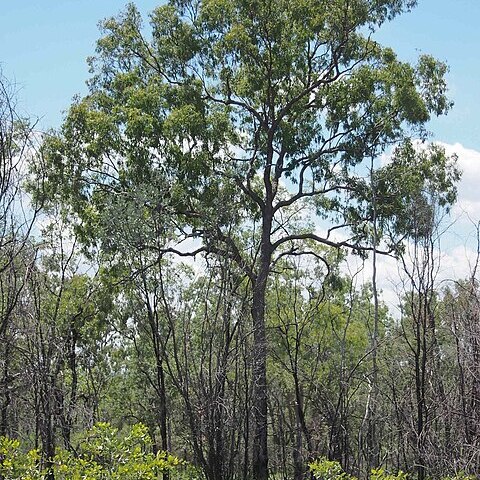Tree to 15 m tall, or sometimes a mallee. Forming both lignotuber and rhizomes. Bark rough on trunk often extending to branches about 6 cm diameter, tessellated, soft, grey, brown and yellow-grey. Juvenile growth (coppice or field seedlings to 50 cm): stem rounded in cross-section, setose at first; juvenile leaves always petiolate, opposite for 2 to 4 nodes then sub-opposite, becoming alternate, lanceolate, 5–12 cm long, 1–3.5 cm wide, base rounded, peltate, discolorous, glossy, green; stems, petioles, and underside of lamina setose for many pairs. Adult leaves alternate, petiole 0.8–2 cm long; blade narrowly lanceolate to lanceolate, 6.5–14 cm long, 0.9–2.6(4) cm wide, base tapering to petiole, usually discolorous, usually glossy and dark green above, strongly penniveined, very densely reticulate, intramarginal vein parallel to and just within margin, oil glands sparse and island, or obscure. Inflorescence terminal compound, peduncles 0.4–1.3 cm long, buds 7 per umbel, pedicel 0.2–0.7 cm long. Mature buds pyriform, 0.4–0.5 cm long, 0.2–0.4 cm wide, yellow or creamy, smooth, scar absent (both opercula shed together at flowering), operculum rounded and sometimes apiculate, stamens inflexed, anthers oblong, versatile, dorsifixed, dehiscing by longitudinal slits (non-confluent), style long, stigma slightly mop-like, locules 3 or 4, the placentae each with 3–5 vertical ovule rows. Flowers white. Fruit pedicellate (pedicels 0.2–0.7 cm long), urceolate, 0.6–1 cm long, 0.5–0.8 cm wide, walls thin, disc descending, valves 3 or 4, enclosed. Seeds brown to yellow to reddish brown, 2–5 mm long, flattened-ellipsoidal with a median dorsal keel, with a very short blunt flange at one end (unwinged), dorsal surface smooth, hilum ventral. Cultivated seedlings (measured at ca node 10): cotyledons reniform to orbicular; stems rounded in cross-section, setose for 12+ nodes or becoming smooth (glabrous) after some 8–10 nodes; leaves always petiolate (to 1.5 cm), opposite for 2 or 3 nodes then subopposite becoming alternate by ca node 7, oblong to lanceolate, 6–16 cm long, 1.5–4 cm wide, base rounded to ca node 4 then peltate, margin entire or irregularly indented, apex pointed or rounded, discolorous, dull, green, setose for ca 12+ pairs at least on underside. The setae are adorned with simple hairs.
More
Tree to 25 m. Bark flaky, tessellated, brown or yellow-grey throughout, sometimes smooth on smaller branches. Juvenile leaves ovate, obtuse, cordate, peltate. Adult leaves narrowly lanceolate to lanceolate, acuminate; lamina 7–12 cm long, 1–2 cm wide, grey-green; lateral veins fine, faint, at 50°–60°; intramarginal vein very close to or confluent with margin; petiole 10–17 mm long. Umbels 3–7-flowered; peduncle terete, 5–13 mm long; pedicels 2–6 mm long. Buds with operculum 1–2 mm long, 2–3 mm wide; hypanthium truncate-pyriform, 3–4 mm long, 2–3 mm wide. Fruits 6–10 mm long, 5–8 mm wide.


